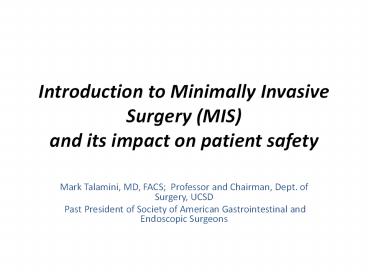Introduction to Minimally Invasive Surgery (MIS) and its impact on patient safety - PowerPoint PPT Presentation
1 / 20
Title:
Introduction to Minimally Invasive Surgery (MIS) and its impact on patient safety
Description:
Introduction to Minimally Invasive Surgery (MIS) and its impact on patient safety Mark Talamini, MD, FACS; Professor and Chairman, Dept. of Surgery, UCSD – PowerPoint PPT presentation
Number of Views:862
Avg rating:5.0/5.0
Title: Introduction to Minimally Invasive Surgery (MIS) and its impact on patient safety
1
Introduction to Minimally Invasive Surgery (MIS)
and its impact on patient safety
- Mark Talamini, MD, FACS Professor and Chairman,
Dept. of Surgery, UCSD - Past President of Society of American
Gastrointestinal and Endoscopic Surgeons
2
Minimally Invasive Surgeries Reduce Healthcare
Acquired Infections and Improve Surgical Quality
3
Minimally Invasive Surgery Introduction and
Overview
4
The standard practice has been evolving to become
less invasive
LAPAROTOMY Up to the 1990s
LAPAROSCOPY 1990s - Today
NATURAL ORIFICE Next step
5
Multi-Stakeholder Value Proposition
Provider Performance Patient Safety
Nosocomial Infections Fewer Hospital Days Less
Pain Medications
Patient Referrals Superior Outcomes
Health Plans
Surgeons
Less pain Quicker RTNA/ RTW Less Scarring,
Pain Patient Satisfaction
Lower LOS Less Absenteeism Disability Increased
Productivity Value Based Medicine
Employers
Minimally Invasive Surgery
Patients
Hospitals
Insurance Brokers Consultants
Value proposition for patients and own
Employees Ability to market MIS program Lower
LOS Lower HAI incidence
Value Proposition To Customers Benefit Design
Strategy
6
Current MIS Adoption Rates
There is opportunity for further MIS adoption
Source Thomson Reuters/Medstat Market Scan.
Claims paid 3Q 2006-2Q 2007.
7
Meta-Analysis Summary
- Summary of 112 articles on MIS vs. open surgical
procedures - Prospective, randomized comparative trials
- Systematic review or meta-analysis
- Prospective, non-randomized comparative trials
- Retrospective, observational studies
- Measures included
- Length of stay (LOS) in the hospital
- Return to Normal Activities (RTNA)
- Return to Work (RTW)
Source Minimally invasive minimally reimbursed?
An Examination of Six Laparoscopic Surgical
Procedures. Roumm A, Pizzi L, Belsky A, et al.
Surgical Innovation, Vol 12, No 3 (September),
2005261-287
8
Weighted Average Results Length of Stay MIS vs
Open
Roumm, et al.
9
Weighted Average Return to Normal Activity-
MIS vs. Open
Roumm, et al.
10
Weighted Average Return to Work MIS vs Open
Roumm, et al.
11
MIS Impact on Nosocomial Infections
- The Effects of Laparoscopic Cholecystectomy,
Hysterectomy, and Appendectomy on Nosocomial
Infection Risks and Associated Costs
Sources Brill A, Ghosh K, Gunnarsson C, Rizzo
J, Fullum T, Maxey C, Brossette S. The effects of
laparoscopic cholecystectomy, hysterectomy, and
appendectomy on nosocomial infection risks. Surg
Endosc. 2008 Apr 22(4)1112-8.
Gunnarsson C., Rizzo J., Hochheiser
L. The effects of laparoscopic surgery and
nosocomial infections on the cost of care. Value
in Health 2008 Jul Vol 12, Issue 1
12
(No Transcript)
13
i3 Innovus/ Ingenix Data Analysis
- Retrospective claims analysis from a large
national health care plan database - 14 million commercial health plan members with a
specified MIS or open surgical procedure from
2006 - Inclusion Criteria Surgical procedure for an
MIS or open procedure from July 1, 2005-June 30,
2006 - Reviewed duration and cost of the
procedure-related episodes of care
Source Ingenix retrospective commercial claims
database analysis. July 1, 2005-June 30, 2006.
14
Study Objectives
- Describe and compare the surgery-related outcomes
for the specified minimally invasive and open
procedures (severity risk adjusted) including - Length of hospital stay (LOS)
- Re-admission rates
- Total procedure-related costs
- Identify complication rates and costs including
- Infection
- Bleeding (major and minor)
- Procedure-specific complications (e.g.,
peritoneal adhesions, bowel perforation)
- The primary outcomes assessed in surgical cohorts
were - post-surgical office visits
- outpatient visits
- inpatient visits
- length of stay
- total health care costs
- APP-area procedure costs
- chest-area procedure costs
- postsurgical complication rates
- associated costs
- duration of episode of care
- cost of episode of care
- bleeding rates (both major and minor)
- post-surgical infection rates
15
i3 Ingenix Data Analysis Summary
16
(No Transcript)
17
i3 Ingenix Data Analysis Conclusions
- The study results have shown that open surgical
procedures are generally associated with - higher health care utilization and
- higher costs for most of the studied procedures
- The study indicates that there is ample
opportunity to optimize the use of health care
resources and minimize the cost of care by
increasing the use and awareness of MIS relative
to open surgery
18
Clinical Evidence for MIS
Source Value Dossier -MIP in Hysterectomy,
Appendectomy, Cholecystectomy Colectomy.
MEDLINE literature analysis of randomized
controlled published studies between 2004-2008.
19
Specialty Society Perspective
- Add SAGES information
- Describe FLS program
20
Nosocomial Infections
- Noting that patients who develop surgical
infections spend, on average, an additional 6.5
days in the hospital and are twice as likely to
die, the report recommends that all hospitals
report and publish surgical infection rates and
suggests that the federal government tie Medicare
payments to compliance with surgical prevention
measures (Consumers Union report, April 2009
Consumer Union release, 4/27 Stockton Record,
4/28).
21
Challenges to Increased MIS Adoption
- Surgeon training and resistance to change
clinical behavior - Initial investment in training and skills is
required for the surgeons to deliver MIS- the ROI
may not be immediately realized - Seasoned surgeons may continue to perform
surgeries with same technique - Lack of patient awareness
- Many patients arent aware of their surgical
options - Lack of incentives or misaligned incentives
- No incentive to change clinical behavior
- Consumer/patient incentives
- Lack of PCP awareness and referral patterns
- May not be up to date on latest surgical options
or specialists who perform MIS - Referral may be made to surgeons who dont
perform MIS

